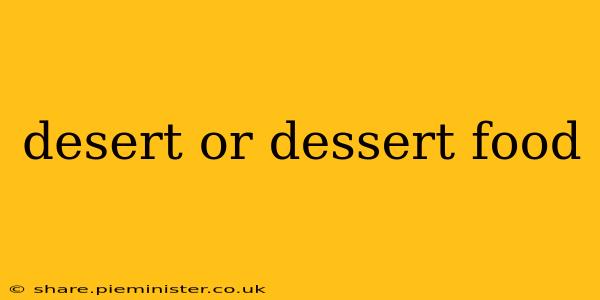The words "desert" and "dessert" are easily confused, leading to embarrassing spelling mistakes and potentially awkward situations. However, understanding the difference is surprisingly simple. Let's dive into the distinction and clear up any lingering confusion.
What is a Desert?
A desert is a geographical region characterized by extremely low precipitation. These arid lands often experience high temperatures during the day and significant temperature fluctuations between day and night. Deserts are diverse ecosystems, supporting unique flora and fauna adapted to survive in harsh conditions. Think of the Sahara Desert, the Gobi Desert, or the Mojave Desert – vast, sandy expanses with sparse vegetation. Key characteristics of a desert include:
- Low precipitation: Annual rainfall is typically less than 250 millimeters (10 inches).
- Extreme temperatures: High temperatures during the day and significant temperature swings between day and night are common.
- Sparse vegetation: Only plants adapted to survive with limited water are found.
- Unique animal life: Animals in deserts have evolved special adaptations to cope with the arid climate.
What is Dessert?
Dessert, on the other hand, refers to a sweet course served at the end of a meal. It's a delightful treat, often involving sugar, fruits, chocolate, or other sweet ingredients. From creamy ice cream to rich cakes and decadent pastries, desserts are a culinary highlight for many. Think of your favorite sweet treats:
- Cakes: Chocolate cake, cheesecake, carrot cake
- Pies: Apple pie, cherry pie, pumpkin pie
- Cookies: Chocolate chip cookies, oatmeal raisin cookies, sugar cookies
- Ice cream: Vanilla ice cream, chocolate ice cream, strawberry ice cream
- Puddings: Rice pudding, chocolate pudding, bread pudding
How to Remember the Difference
A simple mnemonic device can help you remember the distinction: Think of the extra "s" in "dessert" as representing "sweet." A desert is dry and barren, while a dessert is sweet and delicious.
Why is it so easy to confuse them?
The similar spelling is the primary reason for the confusion. The words share a common ancestor, but their meanings diverged over time. The subtle difference in spelling often goes unnoticed, especially during quick typing or handwriting.
What are some common desserts from different cultures?
The world is brimming with diverse and delicious desserts. Here are a few examples:
- France: Crème brûlée, macarons, éclairs
- Italy: Tiramisu, gelato, cannoli
- Japan: Mochi, matcha cake, dorayaki
- Mexico: Churros, flan, tres leches cake
Are there any health considerations related to dessert consumption?
While desserts can be enjoyed as part of a balanced diet, moderation is key. Excessive sugar intake can lead to weight gain, tooth decay, and other health problems. Opting for healthier dessert options, such as fruit-based desserts or those with less added sugar, can help mitigate these risks.
By understanding the subtle yet significant differences between "desert" and "dessert," you can confidently use these words correctly and avoid any future confusion. Remember: one is a dry, arid landscape, and the other is a sweet treat!
